HLTENN003 Assessment: Clinical Assessment and Growth Development
VerifiedAdded on 2023/06/03
|18
|4072
|475
Homework Assignment
AI Summary
This assignment, completed for the HLTENN003 unit in a Diploma of Nursing program, addresses key concepts in human growth and development, clinical assessment, and care planning. It begins with definitions of health and the health-illness continuum, followed by an analysis of individual growth stages based on a provided genogram. The assignment delves into the importance of play in child development and explores the impact of hospitalization on children and their families. It also examines the effects of infertility on couples and summarizes the core standards for supporting individuals with disabilities. Finally, it outlines theories of development for various stages of life, providing a comprehensive overview of the subject matter.
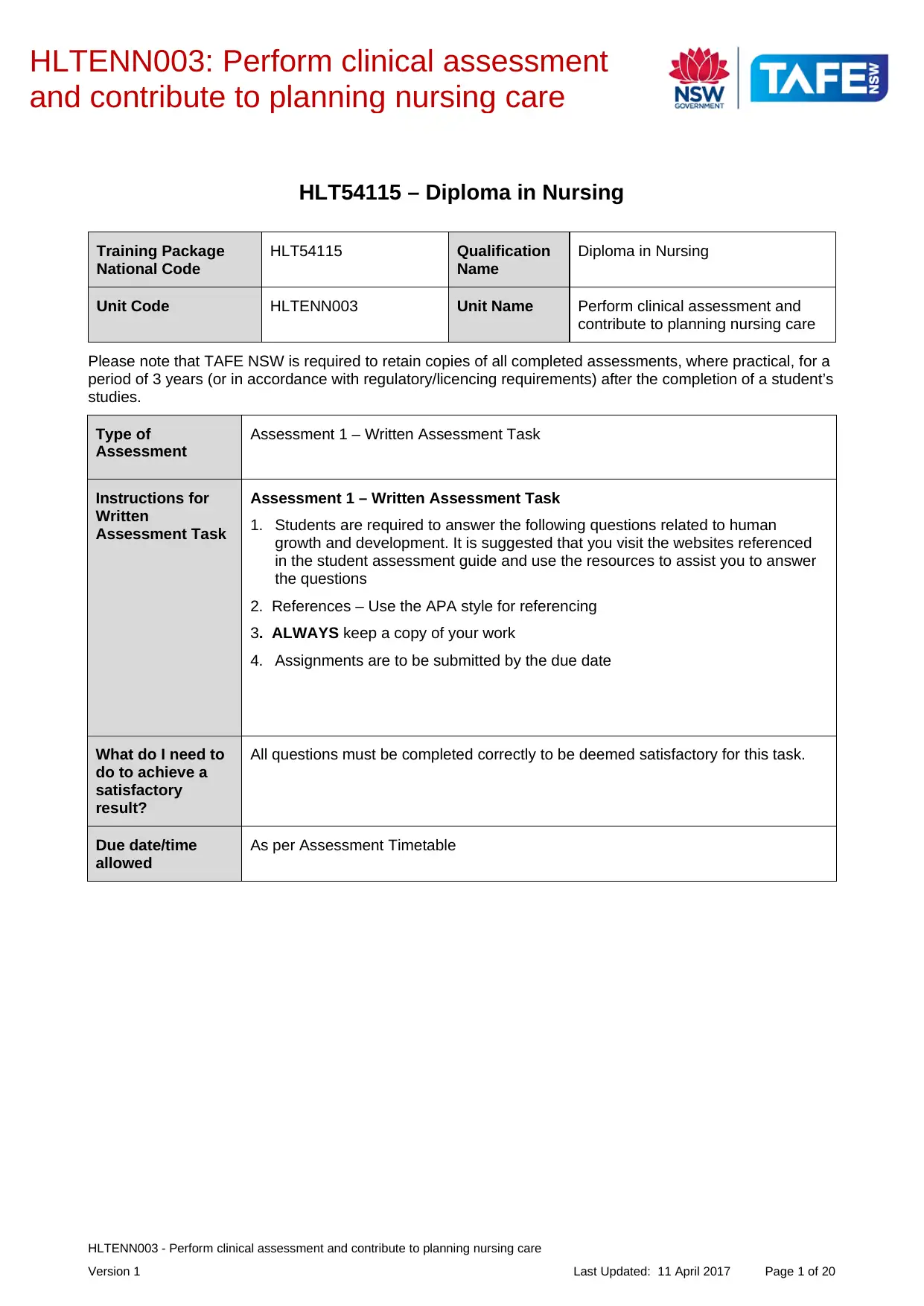
HLTENN003: Perform clinical assessment
and contribute to planning nursing care
HLT54115 – Diploma in Nursing
Training Package
National Code
HLT54115 Qualification
Name
Diploma in Nursing
Unit Code HLTENN003 Unit Name Perform clinical assessment and
contribute to planning nursing care
Please note that TAFE NSW is required to retain copies of all completed assessments, where practical, for a
period of 3 years (or in accordance with regulatory/licencing requirements) after the completion of a student’s
studies.
Type of
Assessment
Assessment 1 – Written Assessment Task
Instructions for
Written
Assessment Task
Assessment 1 – Written Assessment Task
1. Students are required to answer the following questions related to human
growth and development. It is suggested that you visit the websites referenced
in the student assessment guide and use the resources to assist you to answer
the questions
2. References – Use the APA style for referencing
3. ALWAYS keep a copy of your work
4. Assignments are to be submitted by the due date
What do I need to
do to achieve a
satisfactory
result?
All questions must be completed correctly to be deemed satisfactory for this task.
Due date/time
allowed
As per Assessment Timetable
HLTENN003 - Perform clinical assessment and contribute to planning nursing care
Version 1 Last Updated: 11 April 2017 Page 1 of 20
and contribute to planning nursing care
HLT54115 – Diploma in Nursing
Training Package
National Code
HLT54115 Qualification
Name
Diploma in Nursing
Unit Code HLTENN003 Unit Name Perform clinical assessment and
contribute to planning nursing care
Please note that TAFE NSW is required to retain copies of all completed assessments, where practical, for a
period of 3 years (or in accordance with regulatory/licencing requirements) after the completion of a student’s
studies.
Type of
Assessment
Assessment 1 – Written Assessment Task
Instructions for
Written
Assessment Task
Assessment 1 – Written Assessment Task
1. Students are required to answer the following questions related to human
growth and development. It is suggested that you visit the websites referenced
in the student assessment guide and use the resources to assist you to answer
the questions
2. References – Use the APA style for referencing
3. ALWAYS keep a copy of your work
4. Assignments are to be submitted by the due date
What do I need to
do to achieve a
satisfactory
result?
All questions must be completed correctly to be deemed satisfactory for this task.
Due date/time
allowed
As per Assessment Timetable
HLTENN003 - Perform clinical assessment and contribute to planning nursing care
Version 1 Last Updated: 11 April 2017 Page 1 of 20
Paraphrase This Document
Need a fresh take? Get an instant paraphrase of this document with our AI Paraphraser
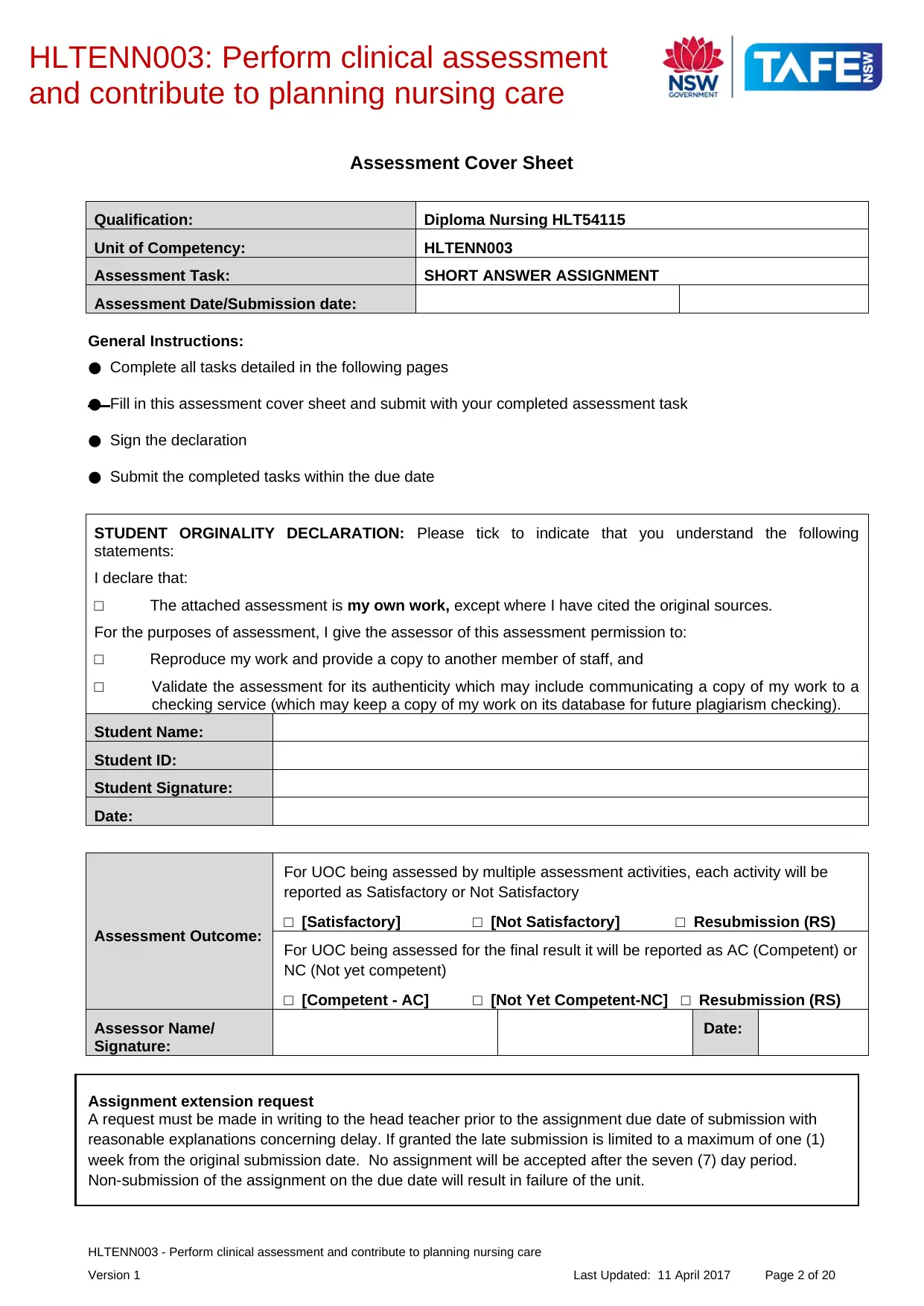
HLTENN003: Perform clinical assessment
and contribute to planning nursing care
Assessment Cover Sheet
Qualification: Diploma Nursing HLT54115
Unit of Competency: HLTENN003
Assessment Task: SHORT ANSWER ASSIGNMENT
Assessment Date/Submission date:
General Instructions:
● Complete all tasks detailed in the following pages
● Fill in this assessment cover sheet and submit with your completed assessment task
● Sign the declaration
● Submit the completed tasks within the due date
STUDENT ORGINALITY DECLARATION: Please tick to indicate that you understand the following
statements:
I declare that:
□ The attached assessment is my own work, except where I have cited the original sources.
For the purposes of assessment, I give the assessor of this assessment permission to:
□ Reproduce my work and provide a copy to another member of staff, and
□ Validate the assessment for its authenticity which may include communicating a copy of my work to a
checking service (which may keep a copy of my work on its database for future plagiarism checking).
Student Name:
Student ID:
Student Signature:
Date:
Assessment Outcome:
For UOC being assessed by multiple assessment activities, each activity will be
reported as Satisfactory or Not Satisfactory
□ [Satisfactory] □ [Not Satisfactory] □ Resubmission (RS)
For UOC being assessed for the final result it will be reported as AC (Competent) or
NC (Not yet competent)
□ [Competent - AC] □ [Not Yet Competent-NC] □ Resubmission (RS)
Assessor Name/
Signature:
Date:
Assignment extension request
A request must be made in writing to the head teacher prior to the assignment due date of submission with
reasonable explanations concerning delay. If granted the late submission is limited to a maximum of one (1)
week from the original submission date. No assignment will be accepted after the seven (7) day period.
Non-submission of the assignment on the due date will result in failure of the unit.
HLTENN003 - Perform clinical assessment and contribute to planning nursing care
Version 1 Last Updated: 11 April 2017 Page 2 of 20
and contribute to planning nursing care
Assessment Cover Sheet
Qualification: Diploma Nursing HLT54115
Unit of Competency: HLTENN003
Assessment Task: SHORT ANSWER ASSIGNMENT
Assessment Date/Submission date:
General Instructions:
● Complete all tasks detailed in the following pages
● Fill in this assessment cover sheet and submit with your completed assessment task
● Sign the declaration
● Submit the completed tasks within the due date
STUDENT ORGINALITY DECLARATION: Please tick to indicate that you understand the following
statements:
I declare that:
□ The attached assessment is my own work, except where I have cited the original sources.
For the purposes of assessment, I give the assessor of this assessment permission to:
□ Reproduce my work and provide a copy to another member of staff, and
□ Validate the assessment for its authenticity which may include communicating a copy of my work to a
checking service (which may keep a copy of my work on its database for future plagiarism checking).
Student Name:
Student ID:
Student Signature:
Date:
Assessment Outcome:
For UOC being assessed by multiple assessment activities, each activity will be
reported as Satisfactory or Not Satisfactory
□ [Satisfactory] □ [Not Satisfactory] □ Resubmission (RS)
For UOC being assessed for the final result it will be reported as AC (Competent) or
NC (Not yet competent)
□ [Competent - AC] □ [Not Yet Competent-NC] □ Resubmission (RS)
Assessor Name/
Signature:
Date:
Assignment extension request
A request must be made in writing to the head teacher prior to the assignment due date of submission with
reasonable explanations concerning delay. If granted the late submission is limited to a maximum of one (1)
week from the original submission date. No assignment will be accepted after the seven (7) day period.
Non-submission of the assignment on the due date will result in failure of the unit.
HLTENN003 - Perform clinical assessment and contribute to planning nursing care
Version 1 Last Updated: 11 April 2017 Page 2 of 20
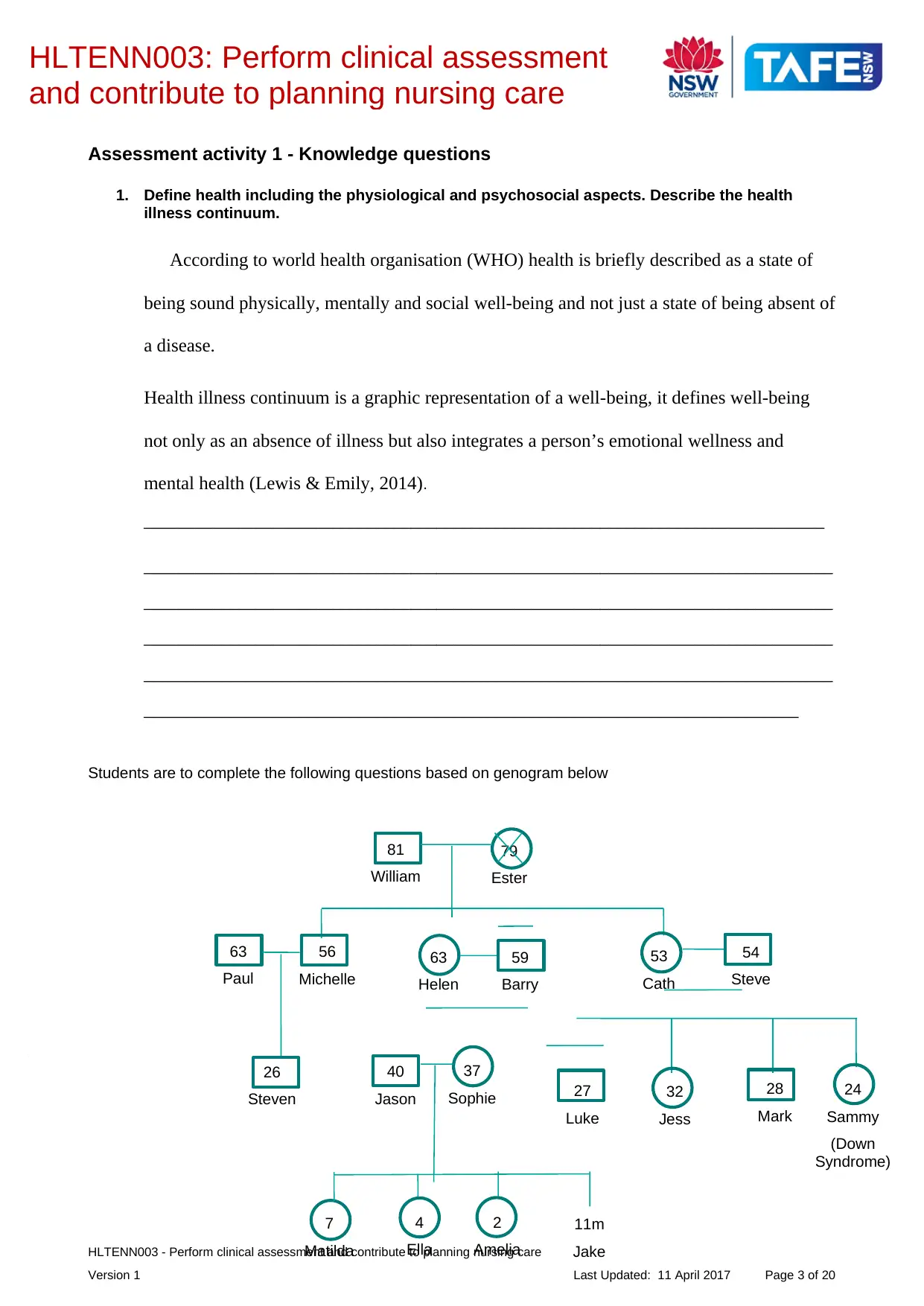
HLTENN003: Perform clinical assessment
and contribute to planning nursing care
Assessment activity 1 - Knowledge questions
1. Define health including the physiological and psychosocial aspects. Describe the health
illness continuum.
According to world health organisation (WHO) health is briefly described as a state of
being sound physically, mentally and social well-being and not just a state of being absent of
a disease.
Health illness continuum is a graphic representation of a well-being, it defines well-being
not only as an absence of illness but also integrates a person’s emotional wellness and
mental health (Lewis & Emily, 2014).
_______________________________________________________________________________
________________________________________________________________________________
________________________________________________________________________________
________________________________________________________________________________
________________________________________________________________________________
____________________________________________________________________________
Students are to complete the following questions based on genogram below
HLTENN003 - Perform clinical assessment and contribute to planning nursing care
Version 1 Last Updated: 11 April 2017 Page 3 of 20
79
Ester
81
William
63
Paul
63
Helen
56
Michelle
59
Barry
53
Cath
54
Steve
37
Sophie
40
Jason 28
Mark
26
Steven 24
Sammy
(Down
Syndrome)
27
Luke
32
Jess
7
Matilda
2
Amelia
4
Ella
11m
Jake
and contribute to planning nursing care
Assessment activity 1 - Knowledge questions
1. Define health including the physiological and psychosocial aspects. Describe the health
illness continuum.
According to world health organisation (WHO) health is briefly described as a state of
being sound physically, mentally and social well-being and not just a state of being absent of
a disease.
Health illness continuum is a graphic representation of a well-being, it defines well-being
not only as an absence of illness but also integrates a person’s emotional wellness and
mental health (Lewis & Emily, 2014).
_______________________________________________________________________________
________________________________________________________________________________
________________________________________________________________________________
________________________________________________________________________________
________________________________________________________________________________
____________________________________________________________________________
Students are to complete the following questions based on genogram below
HLTENN003 - Perform clinical assessment and contribute to planning nursing care
Version 1 Last Updated: 11 April 2017 Page 3 of 20
79
Ester
81
William
63
Paul
63
Helen
56
Michelle
59
Barry
53
Cath
54
Steve
37
Sophie
40
Jason 28
Mark
26
Steven 24
Sammy
(Down
Syndrome)
27
Luke
32
Jess
7
Matilda
2
Amelia
4
Ella
11m
Jake
⊘ This is a preview!⊘
Do you want full access?
Subscribe today to unlock all pages.

Trusted by 1+ million students worldwide
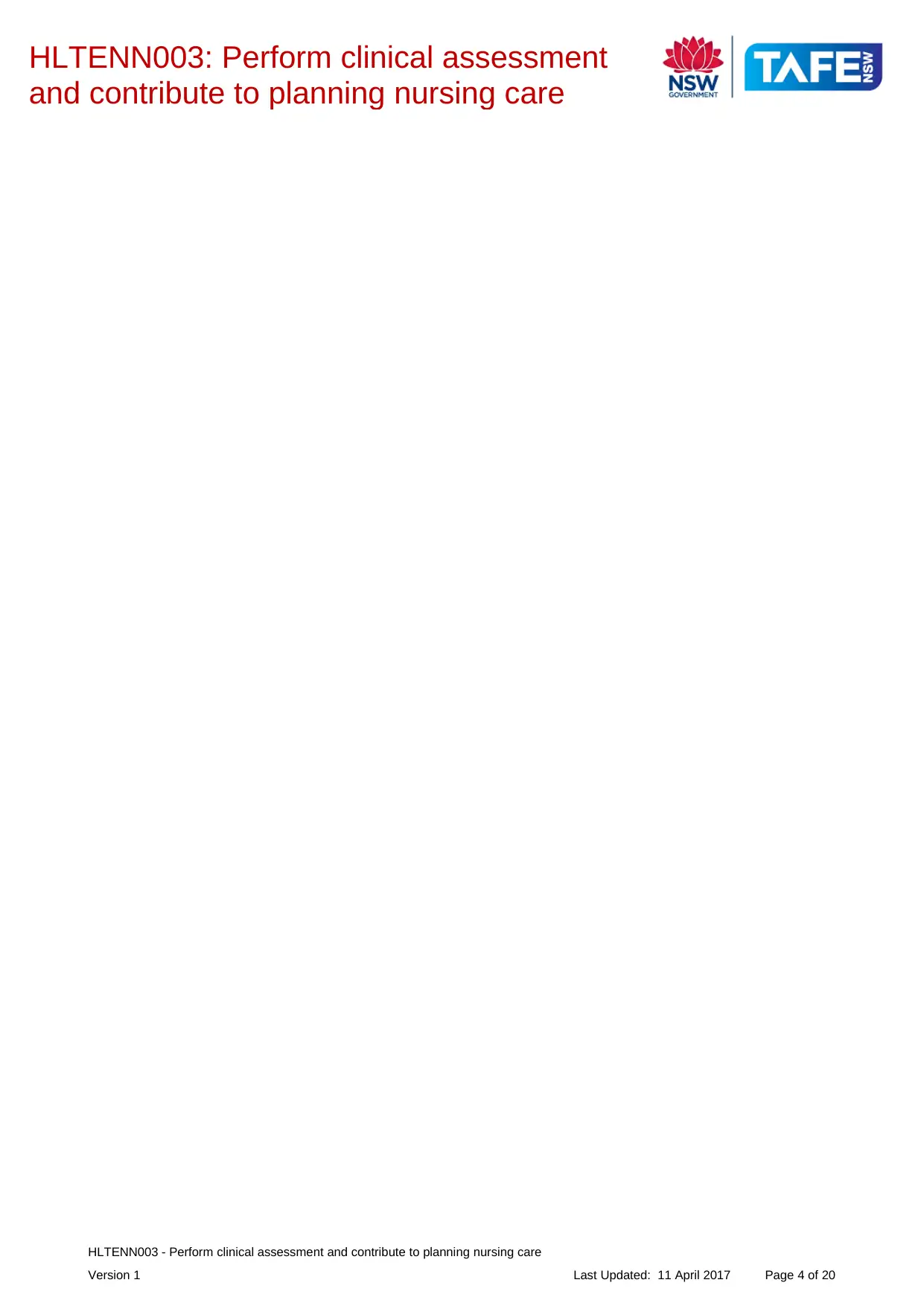
HLTENN003: Perform clinical assessment
and contribute to planning nursing care
HLTENN003 - Perform clinical assessment and contribute to planning nursing care
Version 1 Last Updated: 11 April 2017 Page 4 of 20
and contribute to planning nursing care
HLTENN003 - Perform clinical assessment and contribute to planning nursing care
Version 1 Last Updated: 11 April 2017 Page 4 of 20
Paraphrase This Document
Need a fresh take? Get an instant paraphrase of this document with our AI Paraphraser
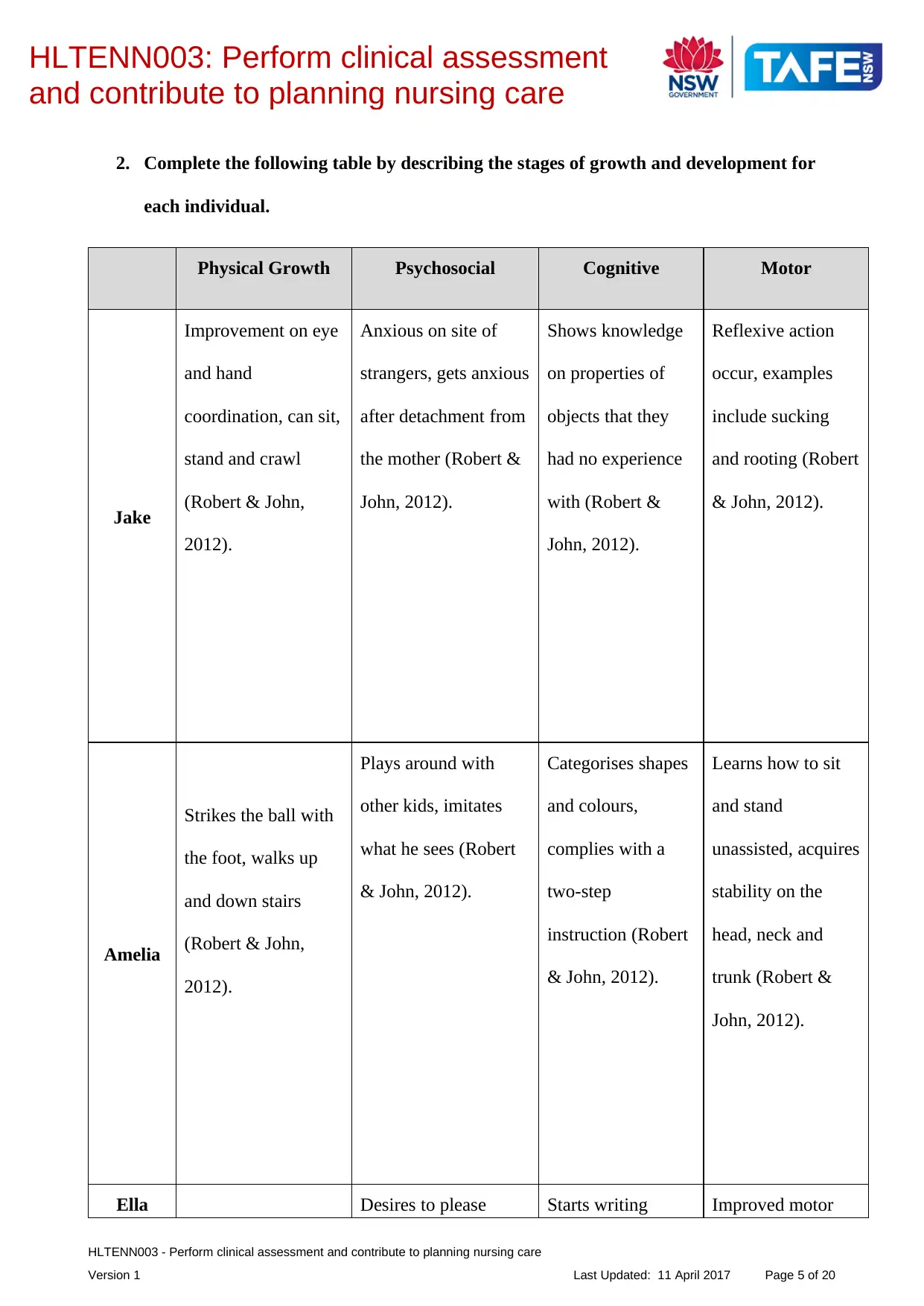
HLTENN003: Perform clinical assessment
and contribute to planning nursing care
2. Complete the following table by describing the stages of growth and development for
each individual.
Physical Growth Psychosocial Cognitive Motor
Jake
Improvement on eye
and hand
coordination, can sit,
stand and crawl
(Robert & John,
2012).
Anxious on site of
strangers, gets anxious
after detachment from
the mother (Robert &
John, 2012).
Shows knowledge
on properties of
objects that they
had no experience
with (Robert &
John, 2012).
Reflexive action
occur, examples
include sucking
and rooting (Robert
& John, 2012).
Amelia
Strikes the ball with
the foot, walks up
and down stairs
(Robert & John,
2012).
Plays around with
other kids, imitates
what he sees (Robert
& John, 2012).
Categorises shapes
and colours,
complies with a
two-step
instruction (Robert
& John, 2012).
Learns how to sit
and stand
unassisted, acquires
stability on the
head, neck and
trunk (Robert &
John, 2012).
Ella Desires to please Starts writing Improved motor
HLTENN003 - Perform clinical assessment and contribute to planning nursing care
Version 1 Last Updated: 11 April 2017 Page 5 of 20
and contribute to planning nursing care
2. Complete the following table by describing the stages of growth and development for
each individual.
Physical Growth Psychosocial Cognitive Motor
Jake
Improvement on eye
and hand
coordination, can sit,
stand and crawl
(Robert & John,
2012).
Anxious on site of
strangers, gets anxious
after detachment from
the mother (Robert &
John, 2012).
Shows knowledge
on properties of
objects that they
had no experience
with (Robert &
John, 2012).
Reflexive action
occur, examples
include sucking
and rooting (Robert
& John, 2012).
Amelia
Strikes the ball with
the foot, walks up
and down stairs
(Robert & John,
2012).
Plays around with
other kids, imitates
what he sees (Robert
& John, 2012).
Categorises shapes
and colours,
complies with a
two-step
instruction (Robert
& John, 2012).
Learns how to sit
and stand
unassisted, acquires
stability on the
head, neck and
trunk (Robert &
John, 2012).
Ella Desires to please Starts writing Improved motor
HLTENN003 - Perform clinical assessment and contribute to planning nursing care
Version 1 Last Updated: 11 April 2017 Page 5 of 20
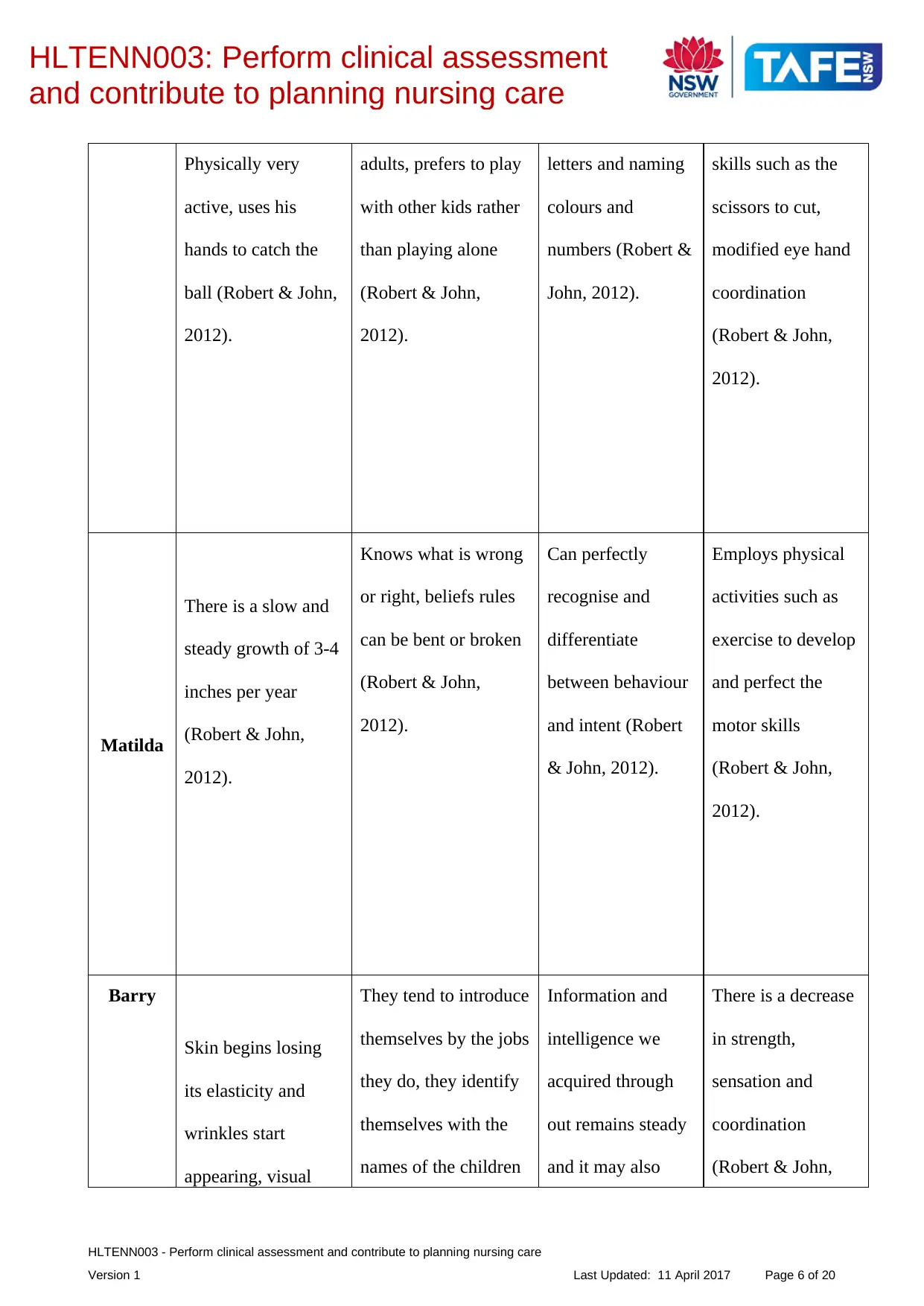
HLTENN003: Perform clinical assessment
and contribute to planning nursing care
Physically very
active, uses his
hands to catch the
ball (Robert & John,
2012).
adults, prefers to play
with other kids rather
than playing alone
(Robert & John,
2012).
letters and naming
colours and
numbers (Robert &
John, 2012).
skills such as the
scissors to cut,
modified eye hand
coordination
(Robert & John,
2012).
Matilda
There is a slow and
steady growth of 3-4
inches per year
(Robert & John,
2012).
Knows what is wrong
or right, beliefs rules
can be bent or broken
(Robert & John,
2012).
Can perfectly
recognise and
differentiate
between behaviour
and intent (Robert
& John, 2012).
Employs physical
activities such as
exercise to develop
and perfect the
motor skills
(Robert & John,
2012).
Barry
Skin begins losing
its elasticity and
wrinkles start
appearing, visual
They tend to introduce
themselves by the jobs
they do, they identify
themselves with the
names of the children
Information and
intelligence we
acquired through
out remains steady
and it may also
There is a decrease
in strength,
sensation and
coordination
(Robert & John,
HLTENN003 - Perform clinical assessment and contribute to planning nursing care
Version 1 Last Updated: 11 April 2017 Page 6 of 20
and contribute to planning nursing care
Physically very
active, uses his
hands to catch the
ball (Robert & John,
2012).
adults, prefers to play
with other kids rather
than playing alone
(Robert & John,
2012).
letters and naming
colours and
numbers (Robert &
John, 2012).
skills such as the
scissors to cut,
modified eye hand
coordination
(Robert & John,
2012).
Matilda
There is a slow and
steady growth of 3-4
inches per year
(Robert & John,
2012).
Knows what is wrong
or right, beliefs rules
can be bent or broken
(Robert & John,
2012).
Can perfectly
recognise and
differentiate
between behaviour
and intent (Robert
& John, 2012).
Employs physical
activities such as
exercise to develop
and perfect the
motor skills
(Robert & John,
2012).
Barry
Skin begins losing
its elasticity and
wrinkles start
appearing, visual
They tend to introduce
themselves by the jobs
they do, they identify
themselves with the
names of the children
Information and
intelligence we
acquired through
out remains steady
and it may also
There is a decrease
in strength,
sensation and
coordination
(Robert & John,
HLTENN003 - Perform clinical assessment and contribute to planning nursing care
Version 1 Last Updated: 11 April 2017 Page 6 of 20
⊘ This is a preview!⊘
Do you want full access?
Subscribe today to unlock all pages.

Trusted by 1+ million students worldwide
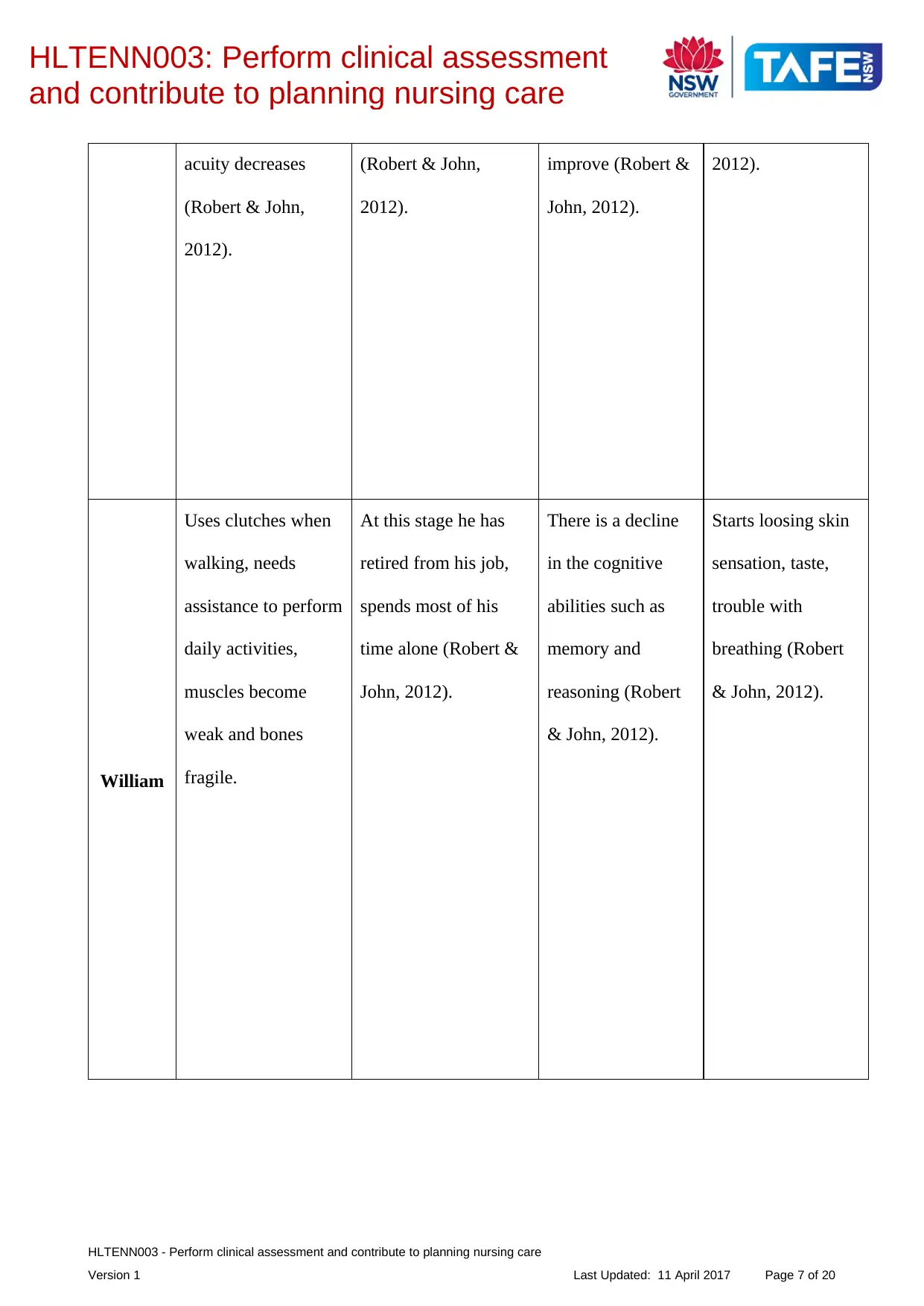
HLTENN003: Perform clinical assessment
and contribute to planning nursing care
acuity decreases
(Robert & John,
2012).
(Robert & John,
2012).
improve (Robert &
John, 2012).
2012).
William
Uses clutches when
walking, needs
assistance to perform
daily activities,
muscles become
weak and bones
fragile.
At this stage he has
retired from his job,
spends most of his
time alone (Robert &
John, 2012).
There is a decline
in the cognitive
abilities such as
memory and
reasoning (Robert
& John, 2012).
Starts loosing skin
sensation, taste,
trouble with
breathing (Robert
& John, 2012).
HLTENN003 - Perform clinical assessment and contribute to planning nursing care
Version 1 Last Updated: 11 April 2017 Page 7 of 20
and contribute to planning nursing care
acuity decreases
(Robert & John,
2012).
(Robert & John,
2012).
improve (Robert &
John, 2012).
2012).
William
Uses clutches when
walking, needs
assistance to perform
daily activities,
muscles become
weak and bones
fragile.
At this stage he has
retired from his job,
spends most of his
time alone (Robert &
John, 2012).
There is a decline
in the cognitive
abilities such as
memory and
reasoning (Robert
& John, 2012).
Starts loosing skin
sensation, taste,
trouble with
breathing (Robert
& John, 2012).
HLTENN003 - Perform clinical assessment and contribute to planning nursing care
Version 1 Last Updated: 11 April 2017 Page 7 of 20
Paraphrase This Document
Need a fresh take? Get an instant paraphrase of this document with our AI Paraphraser
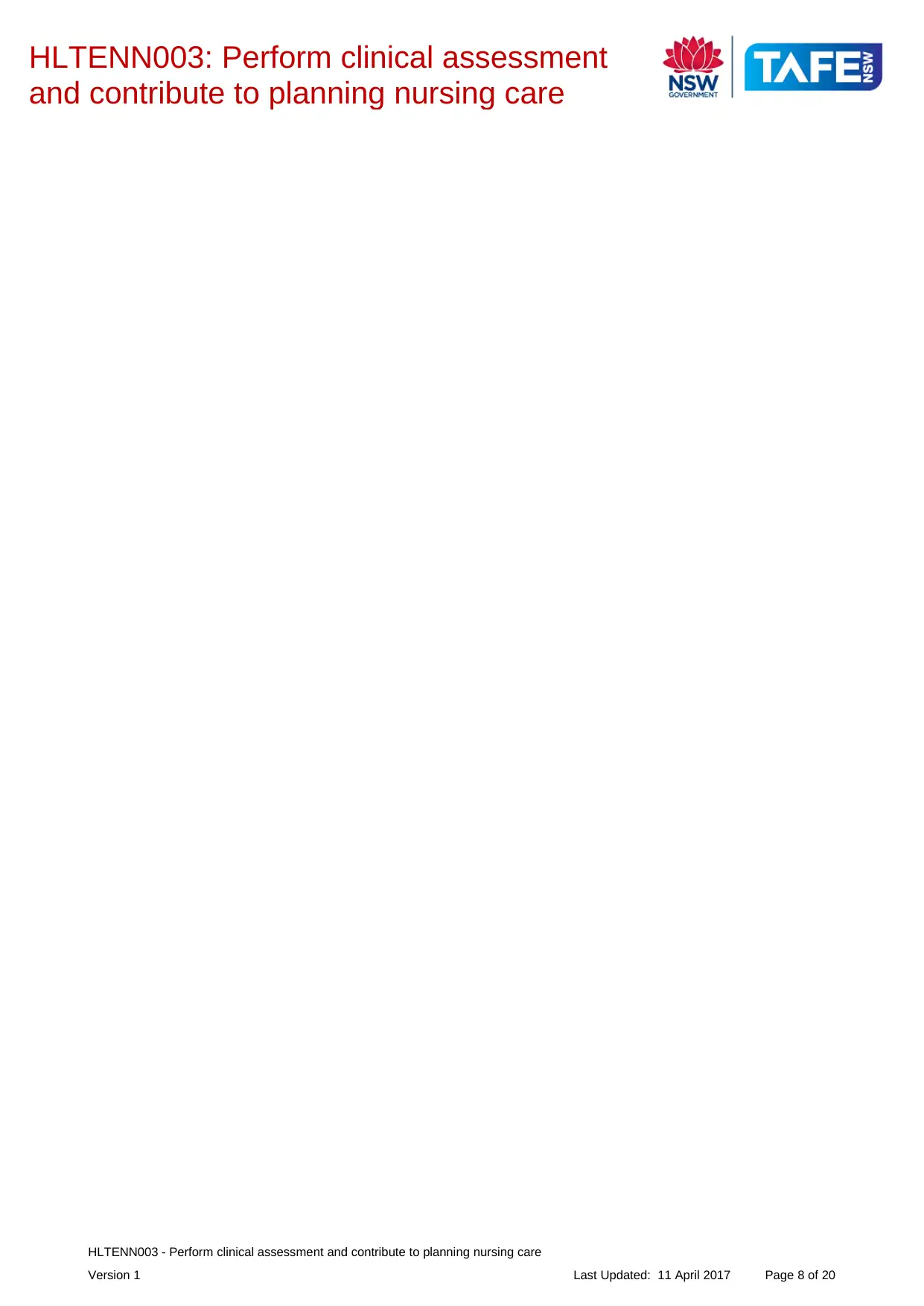
HLTENN003: Perform clinical assessment
and contribute to planning nursing care
HLTENN003 - Perform clinical assessment and contribute to planning nursing care
Version 1 Last Updated: 11 April 2017 Page 8 of 20
and contribute to planning nursing care
HLTENN003 - Perform clinical assessment and contribute to planning nursing care
Version 1 Last Updated: 11 April 2017 Page 8 of 20
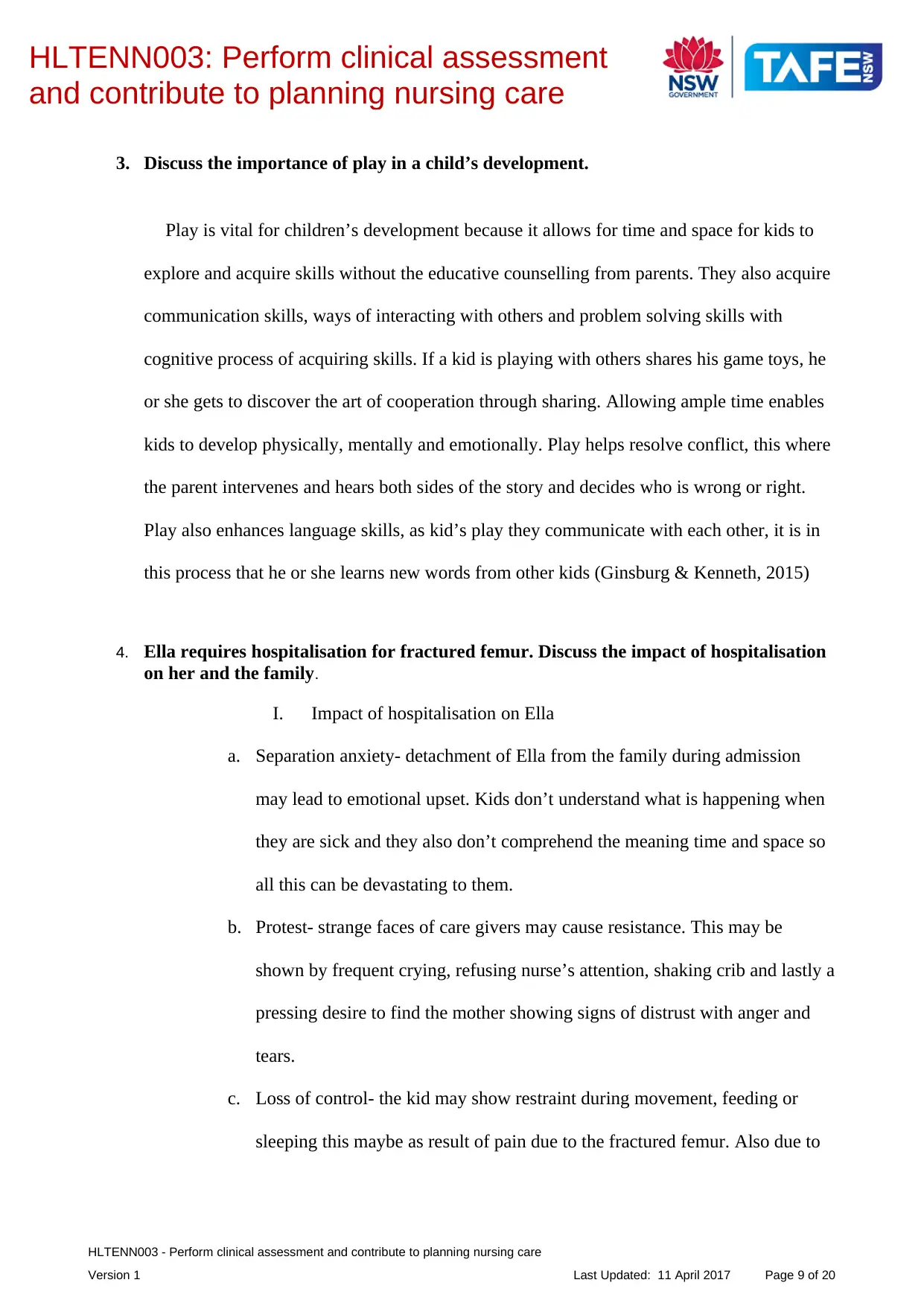
HLTENN003: Perform clinical assessment
and contribute to planning nursing care
3. Discuss the importance of play in a child’s development.
Play is vital for children’s development because it allows for time and space for kids to
explore and acquire skills without the educative counselling from parents. They also acquire
communication skills, ways of interacting with others and problem solving skills with
cognitive process of acquiring skills. If a kid is playing with others shares his game toys, he
or she gets to discover the art of cooperation through sharing. Allowing ample time enables
kids to develop physically, mentally and emotionally. Play helps resolve conflict, this where
the parent intervenes and hears both sides of the story and decides who is wrong or right.
Play also enhances language skills, as kid’s play they communicate with each other, it is in
this process that he or she learns new words from other kids (Ginsburg & Kenneth, 2015)
4. Ella requires hospitalisation for fractured femur. Discuss the impact of hospitalisation
on her and the family.
I. Impact of hospitalisation on Ella
a. Separation anxiety- detachment of Ella from the family during admission
may lead to emotional upset. Kids don’t understand what is happening when
they are sick and they also don’t comprehend the meaning time and space so
all this can be devastating to them.
b. Protest- strange faces of care givers may cause resistance. This may be
shown by frequent crying, refusing nurse’s attention, shaking crib and lastly a
pressing desire to find the mother showing signs of distrust with anger and
tears.
c. Loss of control- the kid may show restraint during movement, feeding or
sleeping this maybe as result of pain due to the fractured femur. Also due to
HLTENN003 - Perform clinical assessment and contribute to planning nursing care
Version 1 Last Updated: 11 April 2017 Page 9 of 20
and contribute to planning nursing care
3. Discuss the importance of play in a child’s development.
Play is vital for children’s development because it allows for time and space for kids to
explore and acquire skills without the educative counselling from parents. They also acquire
communication skills, ways of interacting with others and problem solving skills with
cognitive process of acquiring skills. If a kid is playing with others shares his game toys, he
or she gets to discover the art of cooperation through sharing. Allowing ample time enables
kids to develop physically, mentally and emotionally. Play helps resolve conflict, this where
the parent intervenes and hears both sides of the story and decides who is wrong or right.
Play also enhances language skills, as kid’s play they communicate with each other, it is in
this process that he or she learns new words from other kids (Ginsburg & Kenneth, 2015)
4. Ella requires hospitalisation for fractured femur. Discuss the impact of hospitalisation
on her and the family.
I. Impact of hospitalisation on Ella
a. Separation anxiety- detachment of Ella from the family during admission
may lead to emotional upset. Kids don’t understand what is happening when
they are sick and they also don’t comprehend the meaning time and space so
all this can be devastating to them.
b. Protest- strange faces of care givers may cause resistance. This may be
shown by frequent crying, refusing nurse’s attention, shaking crib and lastly a
pressing desire to find the mother showing signs of distrust with anger and
tears.
c. Loss of control- the kid may show restraint during movement, feeding or
sleeping this maybe as result of pain due to the fractured femur. Also due to
HLTENN003 - Perform clinical assessment and contribute to planning nursing care
Version 1 Last Updated: 11 April 2017 Page 9 of 20
⊘ This is a preview!⊘
Do you want full access?
Subscribe today to unlock all pages.

Trusted by 1+ million students worldwide
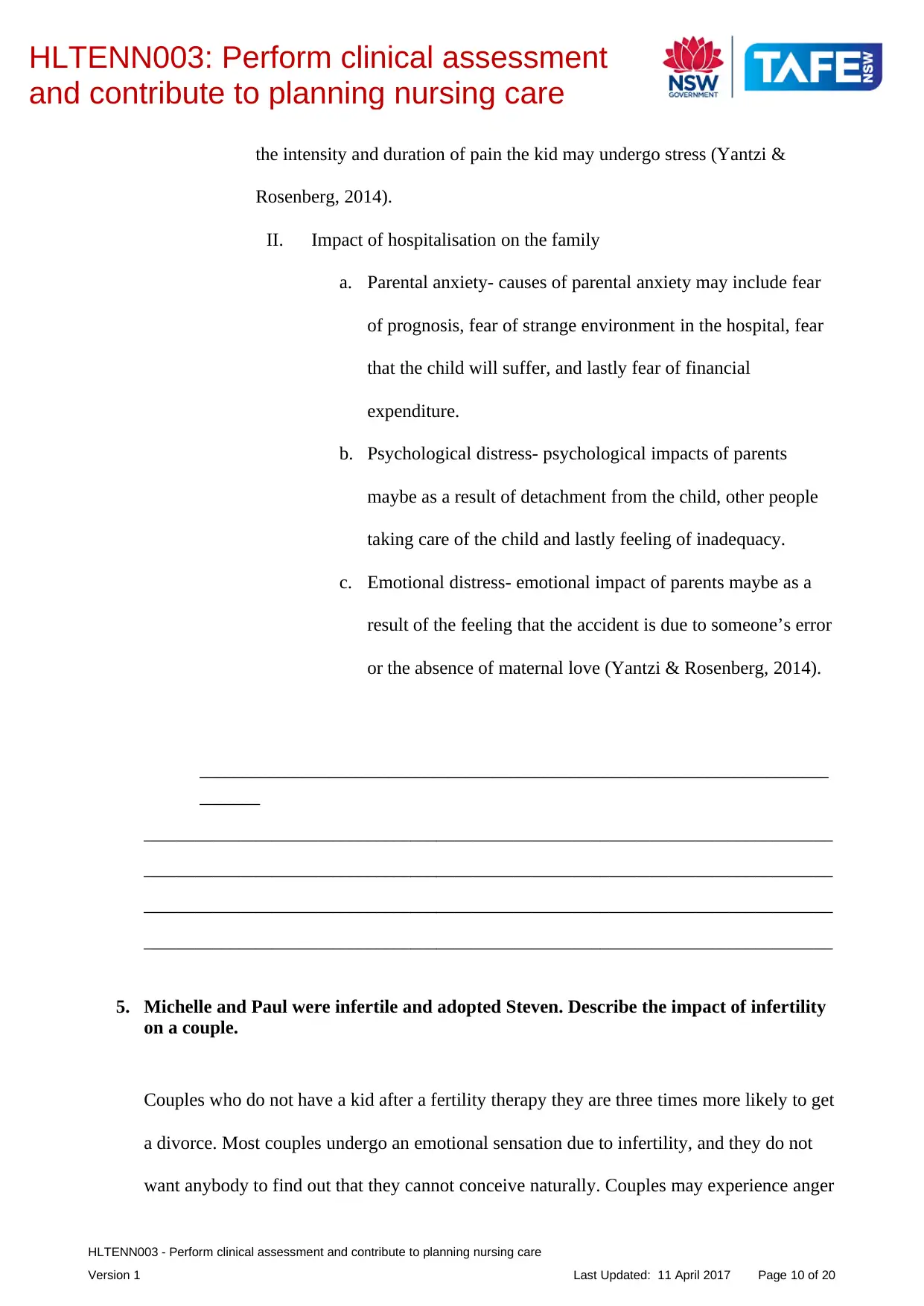
HLTENN003: Perform clinical assessment
and contribute to planning nursing care
the intensity and duration of pain the kid may undergo stress (Yantzi &
Rosenberg, 2014).
II. Impact of hospitalisation on the family
a. Parental anxiety- causes of parental anxiety may include fear
of prognosis, fear of strange environment in the hospital, fear
that the child will suffer, and lastly fear of financial
expenditure.
b. Psychological distress- psychological impacts of parents
maybe as a result of detachment from the child, other people
taking care of the child and lastly feeling of inadequacy.
c. Emotional distress- emotional impact of parents maybe as a
result of the feeling that the accident is due to someone’s error
or the absence of maternal love (Yantzi & Rosenberg, 2014).
_________________________________________________________________________
_______
________________________________________________________________________________
________________________________________________________________________________
________________________________________________________________________________
________________________________________________________________________________
5. Michelle and Paul were infertile and adopted Steven. Describe the impact of infertility
on a couple.
Couples who do not have a kid after a fertility therapy they are three times more likely to get
a divorce. Most couples undergo an emotional sensation due to infertility, and they do not
want anybody to find out that they cannot conceive naturally. Couples may experience anger
HLTENN003 - Perform clinical assessment and contribute to planning nursing care
Version 1 Last Updated: 11 April 2017 Page 10 of 20
and contribute to planning nursing care
the intensity and duration of pain the kid may undergo stress (Yantzi &
Rosenberg, 2014).
II. Impact of hospitalisation on the family
a. Parental anxiety- causes of parental anxiety may include fear
of prognosis, fear of strange environment in the hospital, fear
that the child will suffer, and lastly fear of financial
expenditure.
b. Psychological distress- psychological impacts of parents
maybe as a result of detachment from the child, other people
taking care of the child and lastly feeling of inadequacy.
c. Emotional distress- emotional impact of parents maybe as a
result of the feeling that the accident is due to someone’s error
or the absence of maternal love (Yantzi & Rosenberg, 2014).
_________________________________________________________________________
_______
________________________________________________________________________________
________________________________________________________________________________
________________________________________________________________________________
________________________________________________________________________________
5. Michelle and Paul were infertile and adopted Steven. Describe the impact of infertility
on a couple.
Couples who do not have a kid after a fertility therapy they are three times more likely to get
a divorce. Most couples undergo an emotional sensation due to infertility, and they do not
want anybody to find out that they cannot conceive naturally. Couples may experience anger
HLTENN003 - Perform clinical assessment and contribute to planning nursing care
Version 1 Last Updated: 11 April 2017 Page 10 of 20
Paraphrase This Document
Need a fresh take? Get an instant paraphrase of this document with our AI Paraphraser
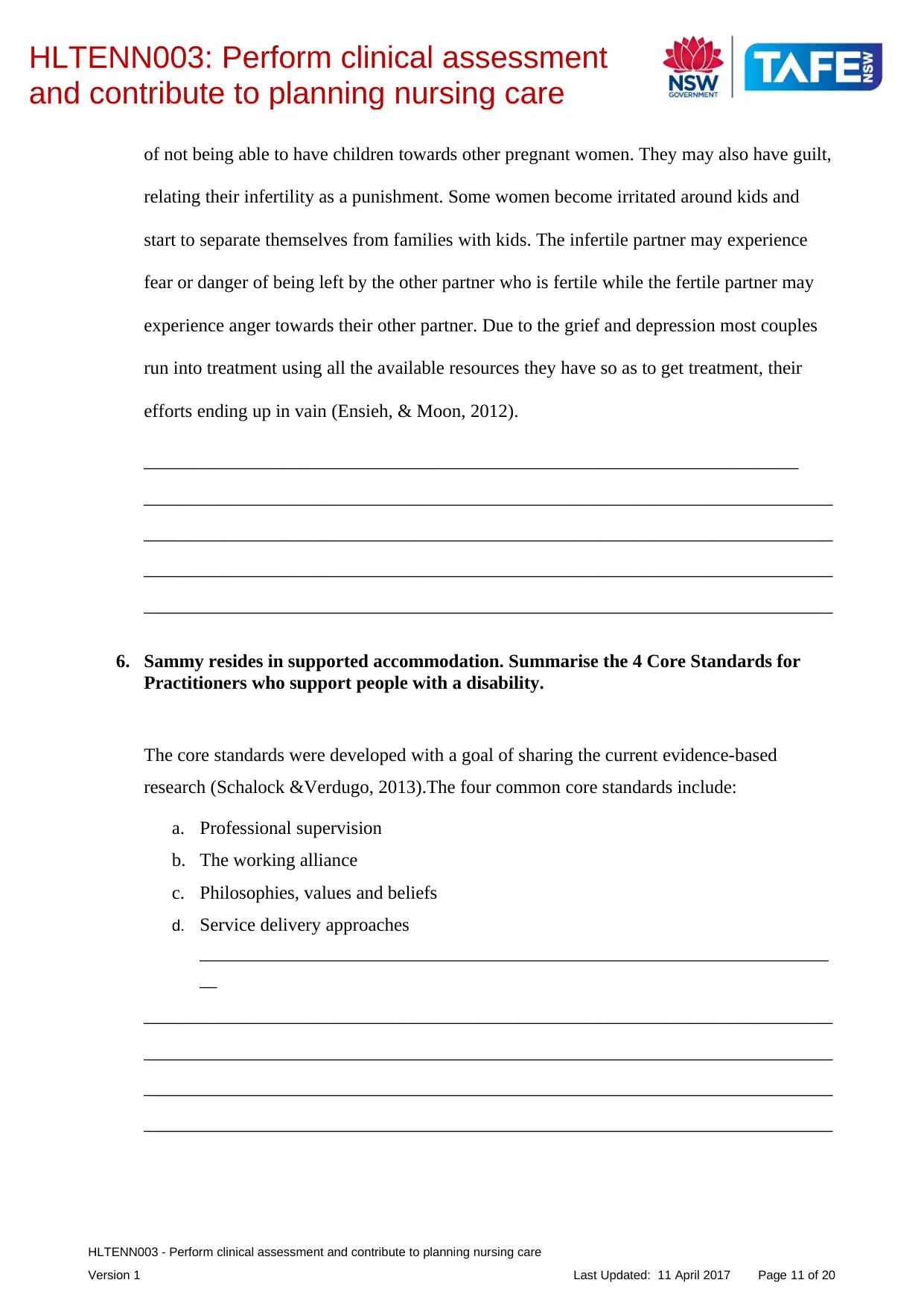
HLTENN003: Perform clinical assessment
and contribute to planning nursing care
of not being able to have children towards other pregnant women. They may also have guilt,
relating their infertility as a punishment. Some women become irritated around kids and
start to separate themselves from families with kids. The infertile partner may experience
fear or danger of being left by the other partner who is fertile while the fertile partner may
experience anger towards their other partner. Due to the grief and depression most couples
run into treatment using all the available resources they have so as to get treatment, their
efforts ending up in vain (Ensieh, & Moon, 2012).
____________________________________________________________________________
________________________________________________________________________________
________________________________________________________________________________
________________________________________________________________________________
________________________________________________________________________________
6. Sammy resides in supported accommodation. Summarise the 4 Core Standards for
Practitioners who support people with a disability.
The core standards were developed with a goal of sharing the current evidence-based
research (Schalock &Verdugo, 2013).The four common core standards include:
a. Professional supervision
b. The working alliance
c. Philosophies, values and beliefs
d. Service delivery approaches
_________________________________________________________________________
__
________________________________________________________________________________
________________________________________________________________________________
________________________________________________________________________________
________________________________________________________________________________
HLTENN003 - Perform clinical assessment and contribute to planning nursing care
Version 1 Last Updated: 11 April 2017 Page 11 of 20
and contribute to planning nursing care
of not being able to have children towards other pregnant women. They may also have guilt,
relating their infertility as a punishment. Some women become irritated around kids and
start to separate themselves from families with kids. The infertile partner may experience
fear or danger of being left by the other partner who is fertile while the fertile partner may
experience anger towards their other partner. Due to the grief and depression most couples
run into treatment using all the available resources they have so as to get treatment, their
efforts ending up in vain (Ensieh, & Moon, 2012).
____________________________________________________________________________
________________________________________________________________________________
________________________________________________________________________________
________________________________________________________________________________
________________________________________________________________________________
6. Sammy resides in supported accommodation. Summarise the 4 Core Standards for
Practitioners who support people with a disability.
The core standards were developed with a goal of sharing the current evidence-based
research (Schalock &Verdugo, 2013).The four common core standards include:
a. Professional supervision
b. The working alliance
c. Philosophies, values and beliefs
d. Service delivery approaches
_________________________________________________________________________
__
________________________________________________________________________________
________________________________________________________________________________
________________________________________________________________________________
________________________________________________________________________________
HLTENN003 - Perform clinical assessment and contribute to planning nursing care
Version 1 Last Updated: 11 April 2017 Page 11 of 20
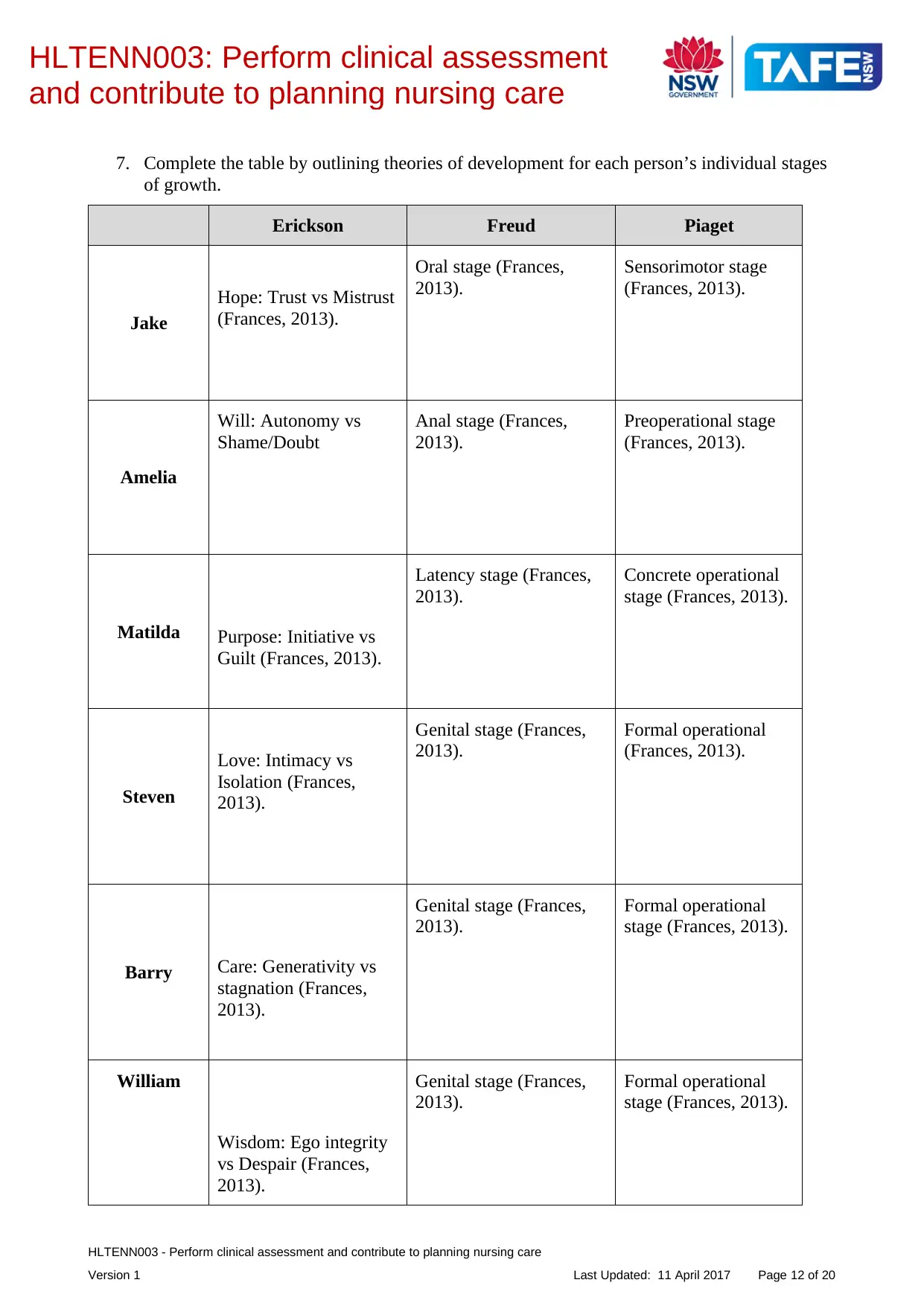
HLTENN003: Perform clinical assessment
and contribute to planning nursing care
7. Complete the table by outlining theories of development for each person’s individual stages
of growth.
Erickson Freud Piaget
Jake
Hope: Trust vs Mistrust
(Frances, 2013).
Oral stage (Frances,
2013).
Sensorimotor stage
(Frances, 2013).
Amelia
Will: Autonomy vs
Shame/Doubt
Anal stage (Frances,
2013).
Preoperational stage
(Frances, 2013).
Matilda Purpose: Initiative vs
Guilt (Frances, 2013).
Latency stage (Frances,
2013).
Concrete operational
stage (Frances, 2013).
Steven
Love: Intimacy vs
Isolation (Frances,
2013).
Genital stage (Frances,
2013).
Formal operational
(Frances, 2013).
Barry Care: Generativity vs
stagnation (Frances,
2013).
Genital stage (Frances,
2013).
Formal operational
stage (Frances, 2013).
William
Wisdom: Ego integrity
vs Despair (Frances,
2013).
Genital stage (Frances,
2013).
Formal operational
stage (Frances, 2013).
HLTENN003 - Perform clinical assessment and contribute to planning nursing care
Version 1 Last Updated: 11 April 2017 Page 12 of 20
and contribute to planning nursing care
7. Complete the table by outlining theories of development for each person’s individual stages
of growth.
Erickson Freud Piaget
Jake
Hope: Trust vs Mistrust
(Frances, 2013).
Oral stage (Frances,
2013).
Sensorimotor stage
(Frances, 2013).
Amelia
Will: Autonomy vs
Shame/Doubt
Anal stage (Frances,
2013).
Preoperational stage
(Frances, 2013).
Matilda Purpose: Initiative vs
Guilt (Frances, 2013).
Latency stage (Frances,
2013).
Concrete operational
stage (Frances, 2013).
Steven
Love: Intimacy vs
Isolation (Frances,
2013).
Genital stage (Frances,
2013).
Formal operational
(Frances, 2013).
Barry Care: Generativity vs
stagnation (Frances,
2013).
Genital stage (Frances,
2013).
Formal operational
stage (Frances, 2013).
William
Wisdom: Ego integrity
vs Despair (Frances,
2013).
Genital stage (Frances,
2013).
Formal operational
stage (Frances, 2013).
HLTENN003 - Perform clinical assessment and contribute to planning nursing care
Version 1 Last Updated: 11 April 2017 Page 12 of 20
⊘ This is a preview!⊘
Do you want full access?
Subscribe today to unlock all pages.

Trusted by 1+ million students worldwide
1 out of 18
Related Documents
Your All-in-One AI-Powered Toolkit for Academic Success.
+13062052269
info@desklib.com
Available 24*7 on WhatsApp / Email
![[object Object]](/_next/static/media/star-bottom.7253800d.svg)
Unlock your academic potential
Copyright © 2020–2025 A2Z Services. All Rights Reserved. Developed and managed by ZUCOL.





